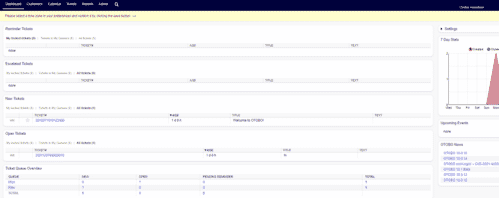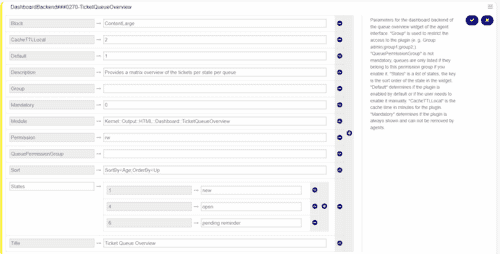Queues in the OTOBO/Znuny Ticket System
Queue management is a central element in OTOBO, the leading open-source ticket system that helps teams efficiently organize and manage their workload. Through a clear structure in queues, work items can be optimally assigned based on various criteria, such as skill level, security level, and area of responsibility. This guide provides detailed information on setting up and managing queues in OTOBO, optimizing your workflow, and ensuring effective ticket processing.
Overview
OTOBO allows work items to be effectively organized and teams to be given structure through queues. In every fresh OTOBO installation, there are four predefined queues: Raw, Junk, Misc, and Postmaster. These serve various purposes, such as collecting all incoming messages in Raw if no filter rules are set, or storing spam in Junk. The Queues module under Ticket Settings allows admins to edit or add new queues as needed.
Managing Queues
Adding a New Queue
- Select Add Queue in the left sidebar.
- Fill in the necessary fields.
- Confirm with Save.
Editing Existing Queues
- Select the desired queue from the overview.
- Make changes to the fields.
- Click Save or Save and Close.
Notes and Tips
INFO
Queues cannot be completely removed from OTOBO/Znuny, but can only be deactivated by setting their Validity to invalid or temporarily invalid.
TIP
Use the filter field to quickly find a specific queue by entering its name.
INFO
When changing a queue name that is used in the System Configuration, a validation check is performed and a warning is issued accordingly. Several options are available to proceed with the change.
Queue Settings
The setting options for queues include, among others:
- Name: The unique name of the queue.
- Sub-queue of: Here, the new queue can be assigned to an existing queue as a sub-queue.
Conclusion
By effectively using queues in the OTOBO ticket system, companies can significantly improve the processing of customer inquiries and internal tasks. Careful configuration and management of queues help teams work in an organized and efficient manner.
Advanced Queue Settings
The effective configuration of ticket queues is crucial for smooth ticket management in OTOBO. With the following settings, the processing time of tickets can be optimized and a higher level of customer satisfaction can be achieved.
Automatic Queue with AI Classification
With AI classification, tickets can be automatically assigned to the correct queue. This saves time and resources and ensures faster processing of requests. More information can be found here: OTOBO AI Ticket Classification
Access Control and Processing Deadlines
- Group: This restricts access to a queue to specific groups, creating a point of contact between queues and user roles (agents or customers).
- Unlock time in minutes: Defines the duration after which a locked ticket is automatically released. A value of 0 means the lock remains until it is manually removed.
Escalation Management
- Escalation - First response time (minutes): Sets a timeframe for the agent's first response to a ticket. Note that this time limit is not activated for emails or calls initiated by the agent.
- Escalation - Update time (minutes) and Escalation - Solution time (minutes): These fields determine the time windows for maintaining communication with the customer and for problem resolution. Note: The solution time is not reset if a ticket is reopened.
Notification Settings
- Notify by: Allows setting notifications based on the progress of the escalation time (specified in percent), to proactively inform both agents and customers.
Handling Follow-ups
- Option for follow-up: Determines the procedure for customer responses to already closed tickets. Options include creating a new ticket, reopening the previous ticket, or rejecting the follow-up.
- Lock ticket after a follow-up: If reopening a ticket is possible, this option can lock the ticket to the last owner to ensure continuous support.
Other Individual Queue Settings
- System address: Sets the sender identity for emails from this queue.
- Default signature key: Becomes active if security keys or certificates are configured, and selects the default key for email signatures.
- Salutation and Signature: Selectable, predefined elements for outgoing communication.
- Calendar: Determines the working hours based on the calendars defined in the system.
- Validity: A central setting that determines if the queue is active.
- Comment: Serves for explanation and can contain additional information or guidelines for using the queue.
Every change to these settings can significantly affect ticket processing. Therefore, the configuration should be carefully planned and regularly reviewed to ensure that the ticket system operates efficiently and is customer-friendly. Detailed knowledge and skillful application of these settings are key factors for the success of any support team using OTOBO.
Ticket Queue Overview
The Ticket Queue Overview is located on the dashboard of the OTOBO ticket system.
OTOBO Dashboard
In the Ticket Queue Overview, a table shows how many tickets are in a specific queue in a certain state.
Dashboard Settings
Each agent has the option to configure the dashboard according to their own preferences.
You can hide the ticket overview by going into the dashboard settings.

OTOBO Dashboard Settings
Ticket Overview Settings
Changes to the Ticket Queue Overview can be made in the [System Configurations.
To do this, you need to change the DashboardBackend###0270-TicketQueueOverview setting.
DashboardBackend###0270-TicketQueueOverview
To configure that a state should no longer be displayed in the overview, it must be removed under the States item by clicking the minus sign.
Adding a New State to the Ticket Queue View
For a newly created state to also be displayed in the Ticket Queue Overview, it must be added with the + sign under States.
The numbers indicate the position, or order, of the states in the ticket overview.
Communication with Auto-Responses
Auto-responses are an essential tool in customer service for reacting quickly and effectively to customer inquiries. In OTOBO, the advanced ticket system, auto-responses provide immediate feedback to customers, informing them that their request has been received and is being processed. This feature is particularly valuable as it manages customer expectations from the start and contributes to increasing customer satisfaction.
Integrating the Chat Channel for Improved Communication
- Chat channel: A specific chat channel can be set for communication in connection with the tickets arriving in this queue. This integration allows for a seamless connection with customers in real-time and expands the communication possibilities within the system.
TIP
Auto-responses require a valid system address. System addresses are configured in the Email Addresses area (Communication and Notifications).
Adding an Auto-Response
- Select Add Auto Response in the left sidebar.
- Fill in all required fields.
- Click Save to apply the settings.
Editing an Auto-Response:
- Select an auto-response from the overview.
- Adjust the fields as needed.
- Confirm the changes with Save or Save and finish.
INFO
Auto-responses cannot be deleted, only deactivated by adjusting the Validity.
Key Settings for Auto-Responses
- Name: Unique identifier of the auto-response.
- Subject: The predefined subject of the email that is sent.
- Response: Content design of the auto-response.
- Type: Determines the event that triggers the sending of the auto-response. The distinction between responses to follow-up requests and auto-responses to new tickets is important here.
The efficient management of auto-responses significantly contributes to the optimization of customer service. By using this feature in OTOBO, the response time to customer inquiries can be drastically reduced and a positive, professional first impression can be left.
Relationship between Queues and Auto-Responses
In OTOBO, structuring queues in combination with auto-responses enables clear and efficient communication with customers. This combination ensures immediate and correct notification of the customer about relevant service information or changes that need to be communicated promptly. OTOBO offers here the flexibility to specifically assign auto-responses to individual queues.
Event Types and Sender Configuration
Auto-responses are triggered based on events defined in OTOBO as follows:
- auto reject: Triggers an auto-response when a customer is prohibited from following up on a closed ticket.
- auto remove: Is sent as soon as a ticket is removed from the system.
- auto reply: Generates an immediate response when a new ticket is created. Depending on the system configuration, this can also apply to tickets submitted via the customer web interface or by phone.
- auto reply/new ticket: Informs the customer about the assignment of a new ticket number, if the original request results in a new ticket.
The effective use of these responses begins with defining the sender email address and the validity of the auto-response to ensure that only activated and relevant communication streams interact with customers.
Flexible Messages with Variables
To ensure that messages are personal and relevant, OTOBO supports the use of variables ( or tags) in the message texts. An example of this is <OTOBO_TICKET_TicketNumber>, which expands to the specific ticket number, effectively achieving a personalization of the communication.
Assigning Responses to Queues
The module area Queues ↔ Auto Responses is used to link one or more auto-responses with specific queues. This allows for detailed control over what information customers receive, based on the origin or type of their request.
Effectively managing these relationships helps maintain consistency in customer communication and ensures that customers always receive the most relevant information. Managing the link between queues and auto- responses is therefore an important pillar for an excellent service experience. Only a few steps are necessary to make such an assignment, and the flexible configuration in OTOBO offers numerous possibilities for optimizing customer communication.
Queues ↔ Auto-Responses
Assigning auto-responses to specific queues is a crucial step to ensure that customers receive the appropriate and necessary information efficiently. In OTOBO, this step can be carried out easily and contributes significantly to customer satisfaction and efficiency in the ticket management system.
Steps to Assign Auto-Responses to Queues
- Select the desired queue from the Queues column.
- Select the auto-responses that should be assigned to this specific queue.
- Confirm the assignment by clicking Save or Save and finish.
INFO
It is not possible to assign multiple queues to an auto-response at the same time. A change in assignment is primarily done by selecting from the queue view.
Optimal Use of Settings
The settings for assigning auto-responses to queues allow for a differentiated reaction to various customer scenarios:
- auto reply: Is the standard reaction for requests that are treated as a new, non-follow-up ticket.
- auto reject: Corresponds to the response for attempted follow-ups that are not allowed due to the queue's reject setting.
- auto follow up: Becomes active for requests that allow a follow-up on existing tickets.
- auto reply/new ticket: The assignment occurs when a follow-up attempt results in the creation of a new ticket.
- auto remove: Takes effect when a ticket is removed from the system.
Please note that auto reply, auto reject, and auto reply/new ticket are mutually exclusive, depending on the settings of the respective queue. It is carefully decided which auto- response is the appropriate feedback for the occurred event.
Conclusion
The precise configuration of the connection between queues and auto-responses in OTOBO is essential to ensure efficient and clear communication with customers. By intelligently assigning these elements, you ensure that your customers are informed promptly and appropriately about the status of their inquiries. A strategically planned setup thus contributes significantly to successful customer service.
Analyzing Queues with Statistics
You can analyze the data from the queues in OTOBO with statistics. For this, there is the option to create new statistics, for example, to analyze how many tickets were created in a specific queue in the last week. Here you can find more information on creating statistics in OTOBO.


![Add Queue Dialog [1]](https://softoft.sirv.com/Images/otobo/docs/queue-add)
![Edit Queue Dialog [1]](https://softoft.sirv.com/Images/otobo/docs/queue-edit)
![Queue Validation Dialog [1]](https://softoft.sirv.com/Images/otobo/docs/queue-system-config-validation)



![Auto-Response Management Screen [1]](https://softoft.sirv.com/Images/otobo/docs/auto-response-management)
![Add Auto-Response Screen [1]](https://softoft.sirv.com/Images/otobo/docs/auto-response-add)
![Edit Auto-Response Screen [1]](https://softoft.sirv.com/Images/otobo/docs/auto-response-edit)
![Variables for Auto-Responses [1]](https://softoft.sirv.com/Images/otobo/docs/auto-response-variables)
![Management between Queues and Auto-Responses [1]](https://softoft.sirv.com/Images/otobo/docs/auto-response-queue-management)
![Screen for Assigning Auto-Responses to Queues [1]](https://softoft.sirv.com/Images/otobo/docs/auto-response-queue-queue)